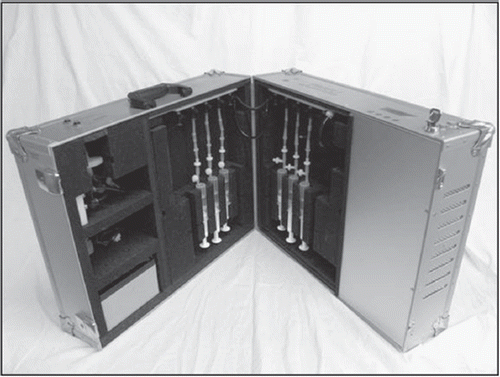Figures & data
Figure 1. A portable microbe enrichment unit (PMEU; Finnoflag Oy and Samplion Oy, Kuopio and Siilinjärvi, Finland) (Citation19).

Table I. Enterobacterial isolates from fecal samples taken at the ages of 3 and 12 months from infants I–VIII.
Table II. Enterobacterial isolates detected by direct plating and enrichment in the PMEU in samples from infants I–VIII.
Figure 2. Cumulative presentation of enterobacterial isolates by species detected only by direct plating (DP), both by direct plating and enrichment (ENR; 8 h, +37°C, MacConkey broth in the PMEU), and only after enrichment at the age of (a) 3 months and (b) 12 months. Note that, at the age of 12 months, on average more Escherichia coli strains were isolated by combination of direct plating and enrichment than by direct plating alone (p = 0.03).

Figure 3. Dendrograms showing phenotypic homologies of the enterobacterial isolates from infants I (a) and III (b) studied by the PhenePlateTM technique (Bactus AB, Huddinge, Sweden) [21,22]. The figures were processed by PhPWIN software (PhPlate AB, Stockholm, Sweden). Isolates were regarded as the same strain when the similarity level was 97.5% or more (marked by a vertical dotted line). (1) Kluyvera ascorbata strain that was isolated from samples taken at the ages of both 3 and 12 months from infant I. (2) Escherichia coli strain that was isolated from samples taken at the ages of both 3 and 12 months from infant III.
![Figure 3. Dendrograms showing phenotypic homologies of the enterobacterial isolates from infants I (a) and III (b) studied by the PhenePlateTM technique (Bactus AB, Huddinge, Sweden) [21,22]. The figures were processed by PhPWIN software (PhPlate AB, Stockholm, Sweden). Isolates were regarded as the same strain when the similarity level was 97.5% or more (marked by a vertical dotted line). (1) Kluyvera ascorbata strain that was isolated from samples taken at the ages of both 3 and 12 months from infant I. (2) Escherichia coli strain that was isolated from samples taken at the ages of both 3 and 12 months from infant III.](/cms/asset/23b061bd-80b8-42e4-9aea-cf02e3afc214/zmeh_a_436959_f0003_b.gif)